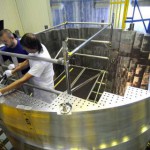The contemporary science class took a field trip to Massachusetts Institute of Technology’s (MIT) Nuclear Reactor Laboratory in Cambridge, Ma. MIT has had the Nuclear Reactor for 52 years, is an interdepartmental center that operates a 6 MW research reactor (MITR-II). A nuclear reactor is an apparatus or structure in which fissile material can be made to undergo a measured, self-sustaining nuclear reaction with the consequential release of energy. MIT’s reactor is used for research which means they generate neutrons for multiple purposes, including producing radiopharmaceuticals for medical diagnosis and therapy, testing materials and conducting basic exploration. The utmost widespread uses for nuclear reactors is as power plants; dedicated to generating heat for electricity production. Their slighter uses are for drinking water or district water production and they also power ships.
The difference between a research nuclear laboratory and a nuclear power plant is the nuclear lab doesn’t burn anything. They use uranium fuel consisting of ceramic pellets (solid), to produce electricity through the process of fission. Nuclear power plants obtain the heat needed to yield steam through a physical process, and is considered a thermal power station. Nuclear research reactors serve primarily as neutron source and are called non-power reactors. The purpose of a research reactor is for neutron scattering or non-destructive testing, production of radioisotopes, research and education. Research reactors are simpler than power reactors and function at lower temperatures. They use less fuel, and less fission products build up as fuel is used. The research reactors also require high powered density core and usually 93% enriched uranium “weapons grade” while a power reactor would only use 20%. Fission is a nuclear reaction or radioactive deterioration process in which the nucleus of a particle splits into lesser particles (lighter nuclei). The fission process often yields free neutrons and photons (gamma rays), and releases an enormous amount of energy to be used later.
MIT’s reactor known as MITR-II is the second largest university research reactor in the United States and is offered a higher neutron flux level. It is a light water cooled and weakened nuclear reactor that utilizes flat plate-type finned, aluminum clad fuel elements. The core reactor consists of rhomboid-shaped elements arranged in hexagonal pattern. Generally there are 24 elements and 3 in-core irradiation positions. The reactors core is surrounded by heavy-water tank, and at the center of a light water tank. It is also surrounded by graphite reflector, thermal shield, and a biological shield. The MIT reactor runs at atmospheric pressure of 55◦C. Some key research done is: time-of-flight experiment, neuron scattering, cancer therapy, specimen examination, and sample transfer.
When the group attended the MIT tour we started off showing a government official ID and signed on a sheet with a Direct Read Pocket Dosimeter to read radiation levels. After that the class was brought upstairs for a short lecture on the nuclear reactor and fission and how it works. Then we were brought into the plant and shown multiple pictures of the core and how it works along with photographs of construction and history involving the reactor. Unfortunately the tour was cut short due to time but the class got to walk up into the catwalk of the inner dome and see where the employees would open the reactor to the core. The most impressive aspect of the tour was the control room. It looked like it had more buttons then a space shuttle and it was too bad we didn’t get to learn more about what the buttons do and the experiments they do. On the way out each student stepped on a machine that detects traces of radiation on the hands and feet which are the primary point’s radiation can transfer to. The class also had to pass through a Geiger counter and read the data on the pocket Dosimeter to triple check for radiation.
Overall I wish the tour lasted longer or more attention was paid to the tour its self and not to the PowerPoint beforehand. The PowerPoint seemed to mostly discuss what was talked about in class and it was a bit of a disappointment to have spent all that time on it. The best place in my opinion was the control room because it was visually interesting and I wish we could have learned more about what can be done within the control room. It would have been fascinating to view a medical room or learn more about what they do at the research reactor and why they do it. It was a great opportunity to understand more about nuclear reactors and that radiation isn’t harmful in moderation as some people believe.
- Core
- Outside MIT Reacter
- Control Room
- Building the Core




